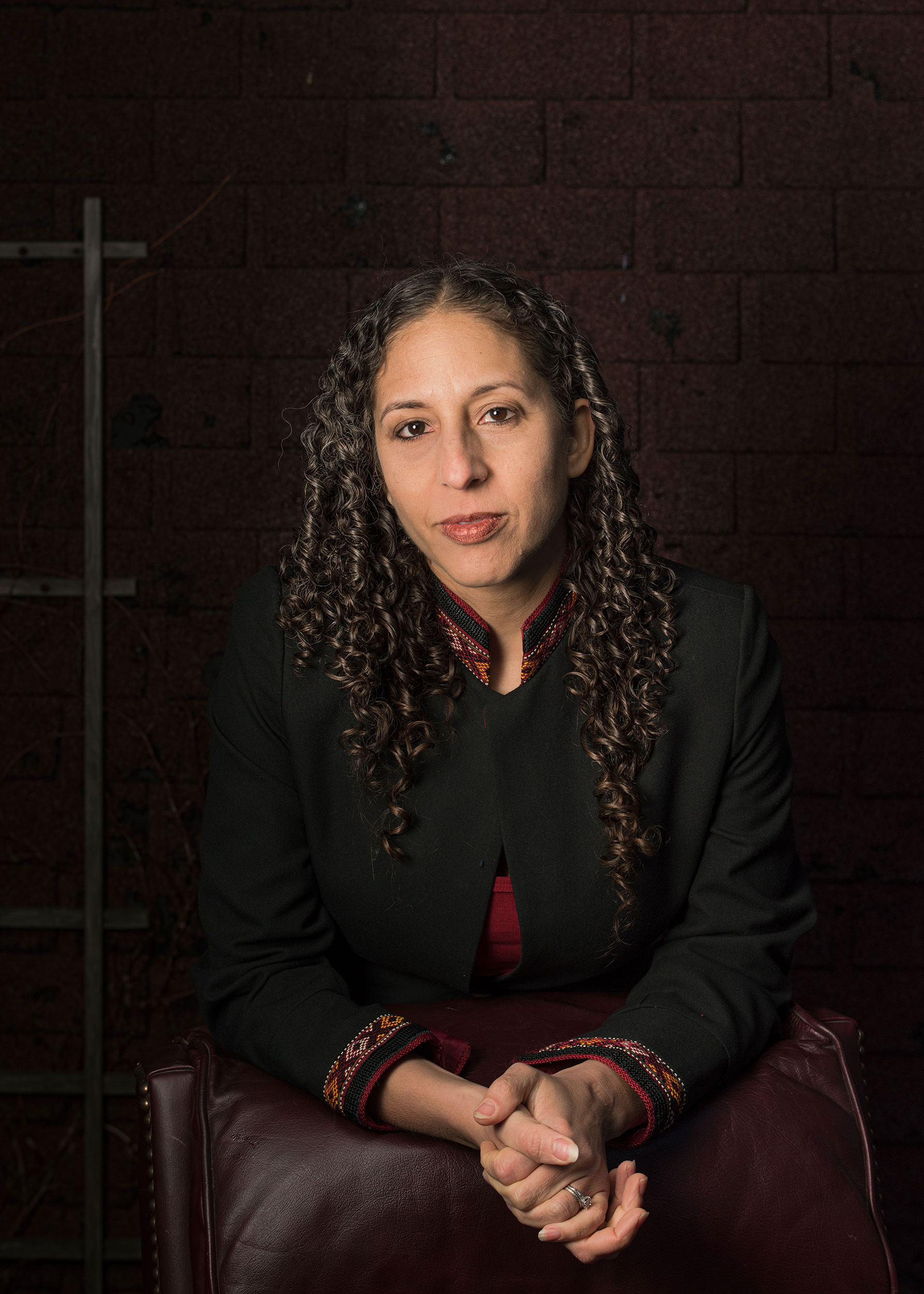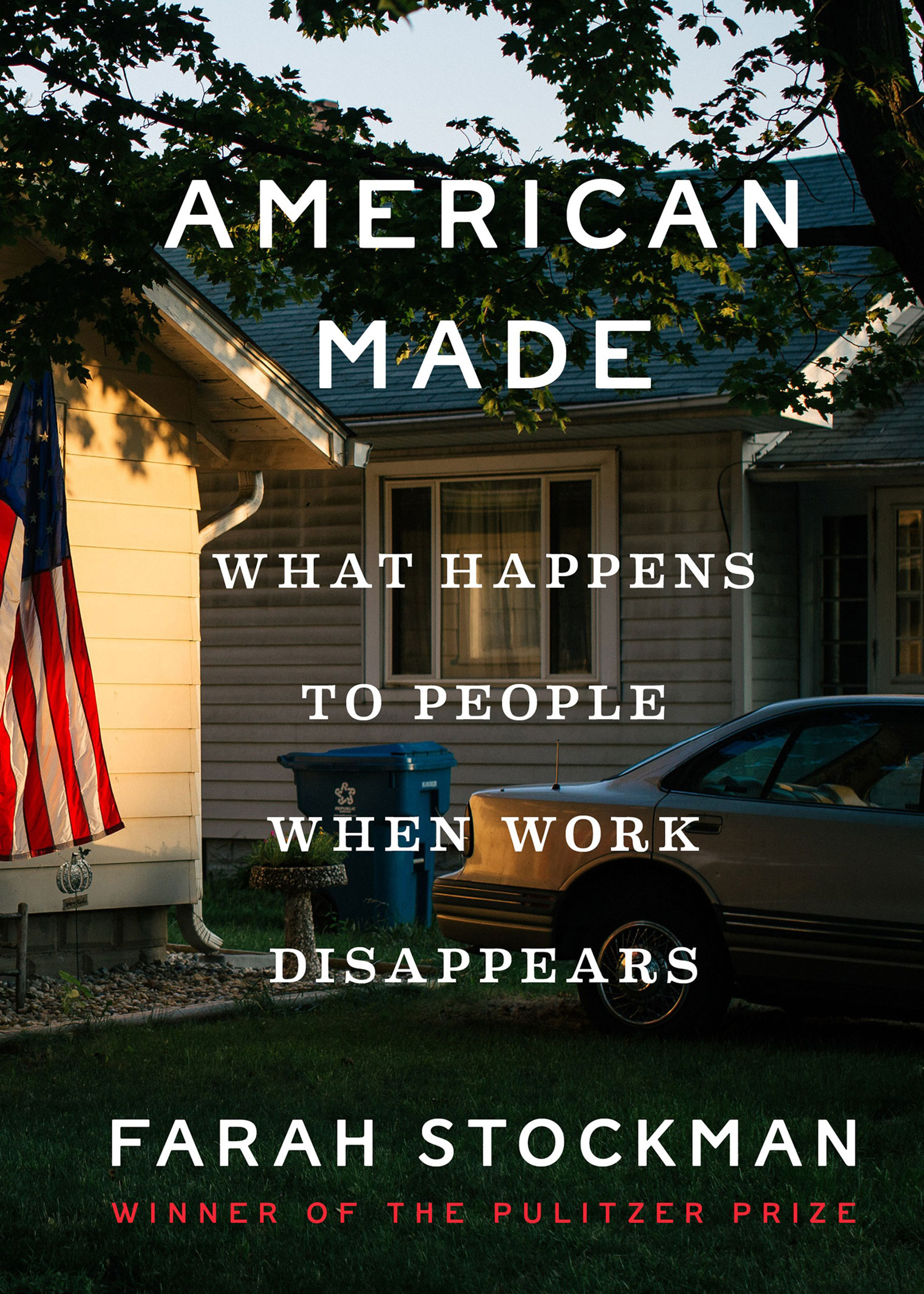What happens to workers when factory shuts down?
Farah Stockman follows unraveling of three lives, examines who wins and loses amid ‘planned obsolescence of people’

“For better or for worse, work provides an essential context of our lives; it contributes to our perceptions of ourselves and our expectations for our children,” writes Farah Stockman in her new book “American Made.”
Bella Wang Photography ©
Excerpted from “American Made: What Happens to People When Work Disappears” by Farah Stockman ’96, member of The New York Times editorial board, published by Random House.
On a cold afternoon, before the end, they sauntered together out to the smoke shack behind the factory in Indianapolis and spent their 15-minute break asking one another “What would you be, if you could be anything, and money didn’t matter at all?”
Inside the Rexnord factory, the machines that were still left on the factory floor beeped and whirred, as if calling out to the machines that had already been taken away. The workers lit their cigarettes and wondered what would become of the people whose names had already made the layoff list.
For the workers, the factory had been a world unto itself. Family dynasties had risen and fallen on the factory floor. In its break rooms, rivals had gone to war and made peace. Under those rows of fluorescent lights, forbidden love had flourished and faded. The factory had a hierarchy and its own etiquette and its own lexicon. Years after it closed, a funny thought would strike someone who’d worked there that could be understood only by someone else who’d worked there, too. Inside its walls, each worker had an identity, a role.
Some worked on the loading dock, carrying steel pipes off trucks and into the plant. Others worked in the turning department, slicing pipes into steel rings as small as a bracelet or as big as a coffee table. Still others piled rings into barrels and wheeled them over to the heat-treat department, where a white woman named Shannon Mulcahy, who loved heavy metal music and abandoned dogs, packed them into wire baskets and sent them into furnaces, hardening them with fire.
Then Shannon sent them across the aisle to the grinding department, where her cousin Lorry honed and polished them. Then Lorry sent them to the open space in the plant where assemblers — the most prolific among them a black man named Wally Hall, who was known for his mouthwatering brisket — put them together inside cast-iron housings. The housings came from department 103, where a white man named John Feltner, who had just recovered from a bankruptcy, carved rough-hewn iron hunks to a specific size and drilled the right number of holes.
The finished product? A steel bearing.
Bearings are gadgets designed to reduce friction. The concept has existed since ancient times, when people transported heavy stone blocks by pushing them atop rolling logs instead of dragging them across the ground. Those logs could be considered the earliest roller bearings. Now countless varieties exist, and they are essential for nearly every machine that moves: Bicycles. Cars. Tanks. Conveyer belts. Wheat combines. Fighter jets. Escalators. Fans.
The state-of-the-art 410,000-square-foot factory opened on the West Side of Indianapolis in 1959 to gushing praise in the Chicago Tribune. Link-Belt, the company that built it, made the “Cadillac of bearings,” so high quality that orders poured in from far-flung corners of the globe: Sugarcane harvesters in Cuba. Iron ore mines in South America. Oil wells in California.
More than half a century later, the building had aged. Its roof leaked brown water onto the machines when it rained. About 300 worked on its factory floor, half the number it had been designed to hold. The plant had been bought and sold many times. The workers had been passed from owner to owner, just like the machines they ran. Rexnord, a Milwaukee industrial supplier, owned it now. But the workers still took pride in the Link-Belt name, which lived on as a brand, written in proud letters on the cast-iron housings of the most expensive bearings they made.
Then the bosses at Rexnord announced that they were closing the factory and moving its work to Monterrey, Mexico, and McAllen, Texas. The news attracted international attention because of a tweet by newly elected President Donald Trump. “Rexnord of Indianapolis is moving to Mexico and rather viciously firing all of its 300 workers. This is happening all over our country. No more!”
The workers sat at the picnic table under the smoke shack’s tin roof and debated what “No more!” meant. Did it mean that no more factories would close after Rexnord? Or did it mean that their jobs would be saved? They went round and round about it until John, the union vice president at the factory, changed the subject.
“What would you be if you could be anything?” he asked them.
They pondered, intrigued. Many of them had worked at the factory since high school.
One guy said that if he could be anything, if he didn’t have to worry about money, he’d be a farmer. He had farmed before. Another said he’d pump gas at a gas station.
A third said, “Honestly, I’d do nothing at all.”
Before John had been hired at the bearing plant, he’d spent several anxious months unemployed, fishing at a pond near his house. If he could be anything, he’d thought then, truly anything, he’d work outdoors.
“I’d probably do something in forestry,” he said.
If Wally had stumbled upon the conversation at the smoke shack that day, he would have impressed them all with his response. He had fantasized for years about starting a BBQ business. Now that the plant was closing, he saw his chance.
Shannon, a single mother, wasn’t sure what she’d do after the factory closed. She had become the first female ever to run the furnaces at the plant. She loved those hulking, fire-belching machines. She’d tended them almost as tenderly as her own children. She had never thought about what she would do if money didn’t matter. She’d grown up hungry in a trailer park. Money had always mattered.
For his 1974 bestseller, “Working: People Talk About What They Do All Day and How They Feel About What They Do,” Studs Terkel interviewed more than a hundred workers, including philosophical steelworkers, middle-aged switchboard operators, newly hired gas-meter readers, and a waitress who boasted about her ability to set a plate on a table so quietly that it did not make a sound.
Back then Terkel could not have predicted how many jobs would be threatened with obsolescence. He wrote his book long before the factories of Indianapolis and Lordstown and Janesville moved to Mexico and China, chasing cheap labor. Nor could he have imagined how many human jobs would be lost to machines. Yet even more than 45 years ago, Terkel managed to pinpoint a chief anxiety of the American working class: “the planned obsolescence of people.”
It is an anxiety that has only grown with time, particularly among unskilled workers, who are sometimes referred to as the “precariat” because of the precariousness of their jobs. Millions of Americans are coming of age in places where most of the jobs that exist are expected to be outsourced, offshored, or automated in the coming decades. Even the harried fast-food worker at the drive-through window cannot sleep easy at night without fear of being replaced by a robot. This is the final insult of menial, poorly paid work: The CEO will eventually find a way to get rid of it — of you — altogether.
This book is about what happened to three people after their factory moved to Mexico: John, a white man, Shannon, a white woman, and Wally, a black man. It tells the story of how they got their jobs, how they were trained for their jobs, and what happened to them after their jobs moved away. It examines the reasons these three people who worked in the same factory reacted in vastly different ways to its demise. It also illustrates how their differences prevented them from speaking with one voice when the company laid them off.

Their stories represent three threads in the larger saga of work in America. Jobs lie at the core of the social justice movements of our time: the labor movement, the women’s rights movement, and the civil rights movement.
Black people didn’t risk their lives to vote just because they liked voting. Casting a ballot is not an end in itself. They risked their lives to elect leaders who would help them access the well-paid jobs they had long been denied. The march on Washington in 1963 — where Dr. Martin Luther King, Jr., delivered his famous “I Have a Dream” speech — was called the March on Washington for Jobs and Freedom. Jobs came first, even before freedom. What good was the right to sit at a lunch counter if you couldn’t afford a meal? “If a man doesn’t have a job or an income, he has neither life nor liberty nor the possibility for the pursuit of happiness,” King declared in a speech he gave in 1968, just days before his death.
Work matters. Too often, those who champion the working class speak only of social safety nets, not the jobs that anchor a working person’s identity. Too often, when we discuss the fate of laid-off American factory workers, we forget what we learned in the 1960s, when Betty Friedan’s “The Feminine Mystique” argued for the psychic importance of jobs outside the home for women; or in the 1990s, when William Julius Wilson’s “When Work Disappears: The World of the New Urban Poor” spelled out the social consequences of the loss of work for urban blacks.
For better or for worse, work provides an essential context of our lives; it contributes to our perceptions of ourselves and our expectations for our children. More often than we may acknowledge, it determines our place in society’s hierarchy. It formulates who we are, who we meet, who we marry, and who cries at our graves after we die. “As a society, we are what we do at work,” Jacqueline Jones wrote in her authoritative history “American Work: Four Centuries of Black and White Labor,” “and we remain the sum of our radically divergent workplaces.”
Jobs lie at the heart of the social contract between citizens and their leaders. In a healthy society, it is the job of workers to work and the job of leaders to ensure that enough jobs are available for ordinary people to make a decent living.
The loss of well-paid blue-collar employment has upended the political order, bolstering the appeal of a presidential candidate who promised, in rally after rally, to bring back American jobs.
Many educated people felt sure that nothing could be done about the irresistible forces that sent those jobs abroad. They dismissed Donald Trump as a con artist who peddled false hope. “The factories are never coming back,” they declared. They forgot that even false hope is a form of hope, perhaps the most ubiquitous kind.
Now our country is grappling with a new wave of job displacement brought on by artificial intelligence. A global pandemic has accelerated the trend of humans being replaced by machines that don’t call in sick and don’t have to quarantine. Millions of jobs have disappeared, and millions more will disappear in the future. It’s not clear how the country will cope.
Some people have begun to talk about “universal basic income,” a naked admission that a significant portion of the American people no longer fits into the economy. That might be part of the solution. But it’s far from clear that a government check can replace what people get from a good job.
I didn’t know much about factories or blue-collar workers when I started researching this book in 2017, even though there are factory workers in my family tree. My father’s mother, the daughter of Italian immigrants, stitched dresses in a warehouse in New York City. My mother’s aunt, a black woman from Jim Crow Mississippi, brought her family to the auto plants of Detroit. Two of my cousins, black men in Mississippi and Alabama, work in auto plants in the South. And my father’s sister, a white woman in Pennsylvania, worked in the offices of a factory that moved to Mexico.
My parents never worked in factories. They went to college on scholarships and loans and became tenured professors. I grew up a faculty brat in a college town in Michigan. Before I started researching this book, nearly every person I interacted with on a daily basis had a bachelor’s degree. Yet only about a third of American adults have one.
As the child of a black woman and a white man, I grew up steeped in conversations about race. Yet awareness of my own class privilege somehow eluded me. As a little kid, I once stared for too long at a waiter in a restaurant and was shocked when he hurried over and asked me if there was something I wanted. I shook my head vigorously and thought it odd for a grown man to be so attentive to a child.
I went off to college, where I earned money working at a graduate-student dining hall three nights a week, spooning spaghetti sauce onto plates. On the serving line, I enjoyed the camaraderie I found, which so much of the campus lacked. Our supervisor, a middle-aged white woman with a thick Boston accent, joked about taking us to a male strip club called the Golden Banana. I did not understand at the time that a bright, yet unspoken, line divided us. We undergraduates would be gone in a few years, on our way to becoming ambassadors, perhaps, or tenured professors or journalists. She’d remain in her job, if she was lucky.
At first the tale of the doomed Rexnord factory seemed familiar — sad but hardly shocking. As a New York Times reporter I kept vigil for the dying plant as one would an elderly patient in hospice whose impending death could not be helped. But the more time I spent with the workers, the more I began to question how our economic system works and who it works for. In the grand bargain that is the U.S. economy, the “planned obsolescence” of swaths of American workers has fattened the stock portfolios of college-educated people like me and flatlined the income of people like them.
The more time I spent with Shannon, Wally, and John, the better I understood what the job at the bearing plant had meant to them. It had rescued Shannon from an abusive man, thrown Wally a lifeline out of a dangerous world, and handed John a chance to regain what he’d lost. The machines there might have been old and cranky. The floors might have been coated in grime. The roof might have leaked brown water when it rained. But for the lucky few who’d managed to get jobs there, it had been a place of identity, belonging, and redemption.
Copyright © 2021 by Farah Stockman. Reprinted by arrangement with Random House, a division of Penguin Random House LLC. All rights reserved.




